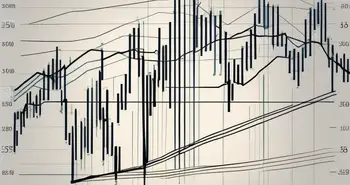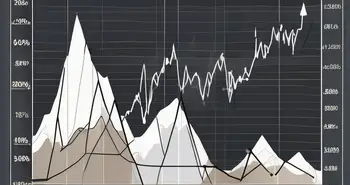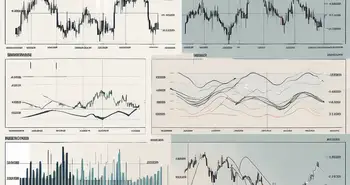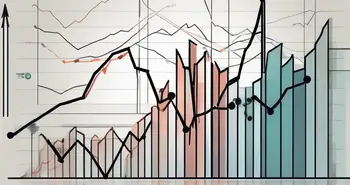Most Volatile Stocks to Invest In (2024 Edition)
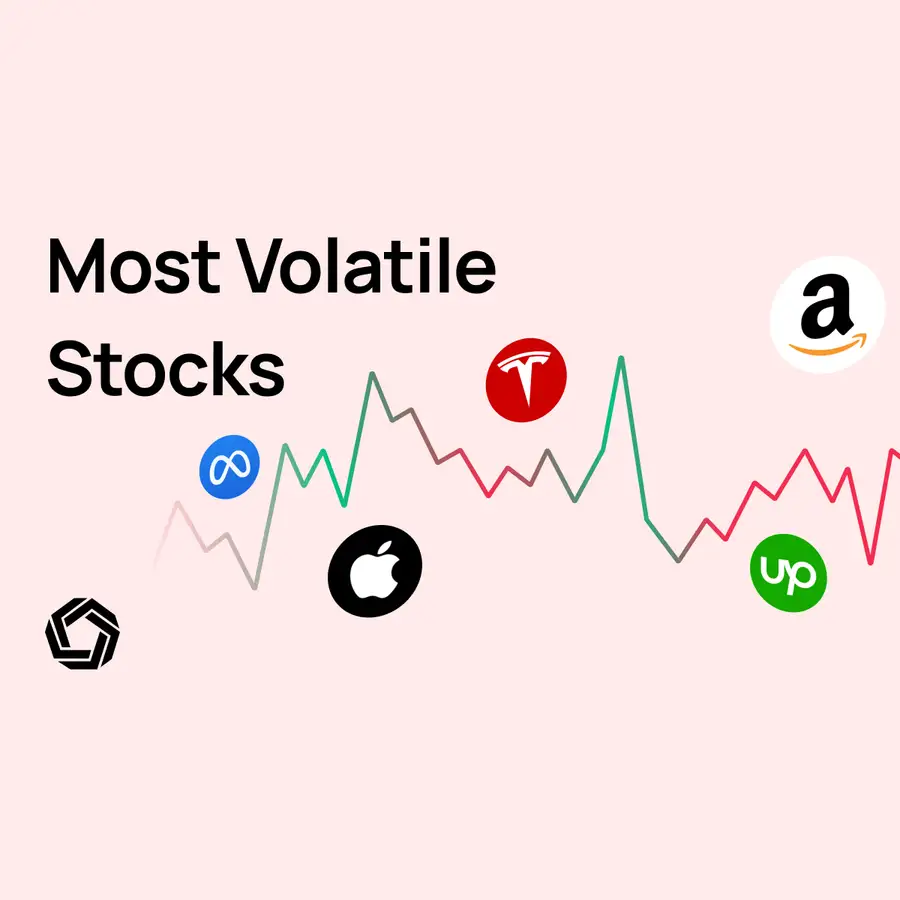
Volatility isn't just a financial term—it's the heartbeat of the stock market, creating a rhythm that traders live by. It shows how much an asset’s price can change in a short amount of time. If the price changes a lot, it creates opportunities for traders to make profits. In 2024, the market's pulse is stronger than ever, driven by a whirlwind of global events and technological shifts. Embracing this volatility can open the door to significant gains.
Join us as we explore the most volatile stocks to invest in this year. We'll look into into recent market trends, share real historical examples, and arm you with the insights needed to navigate this exhilarating but unpredictable terrain in 2024.
Factors That Contribute to Stock Volatility
Before we dive into our curated list of volatile stocks, let's briefly provide you with some actionable examples of factors that can influence a stock's volatility. We recommend not skipping this section. While the most volatile stocks may vary over time, understanding the causes of volatility ensures you can always maintain an updated list yourself.
Market News
We might have already noted the influence of market news. It's one of the primary drivers that can sway sentiments on Wall Street. Our favourite way to describe this phenomenon is from Seth Klarman's iconic “The Margin of Safety”:
“Speculators are always trying to predict the direction of stock prices. Every morning on cable TV, every afternoon with the stock market report, every weekend in Barron's, every week in numerous market newsletters, and at business gatherings, there's constant speculation about where the market is heading.”
From our observations, much of the market news is mere noise. Acting on such news resembles a school of fish all moving together. But if we always follow the crowd, we shouldn't expect exceptional returns. Some might even say, referencing Einstein, that it's insanity to repeat the same actions and anticipate different outcomes.
Even though market news can lead to significant stock movements, we recommend filtering out the distractions before making any trading decisions. One strategy might be following Activist Short Sellers. They aim to pinpoint stocks that appear overvalued due to issues such as potential fraud, misreporting, or other internal challenges.
For instance, Hindenburg, a renowned short seller, mentions on their website that they look for “man-made disasters”, which include accounting mishaps, poor management, and undisclosed internal transactions.
They establish a substantial short position when they identify such a company and then release a detailed news report revealing their findings. Ideally, this news prompts a sell-off of the company's stock, further benefiting their short position. One might question the effectiveness of this strategy. Does it truly work? Based on our observations, it indeed does. The chart below showcases the top-performing short activists of 2023, who have accurately predicted significant price drops in various stocks. For instance, some of these “Activist Short Sellers” achieved average returns of up to 63% in 2023.
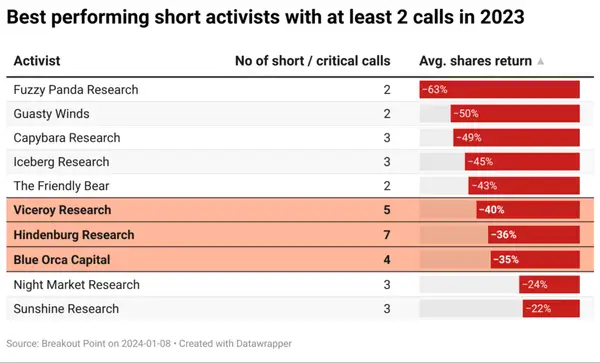
To see such an example in action, let’s take the Hindenburg Report on Nikola (NKLA). They published their report on the 10. September 2020, and once the news reached the market, the stock of the company went from $54 per share on 09. September to $16 only 12 trading days after. That is a stunning -70% decline caused by these news.
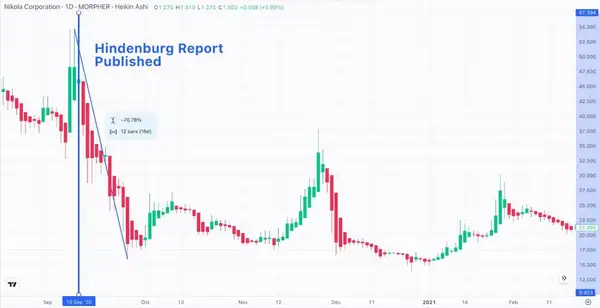
To stay updated with the latest market news, you don't need multiple subscriptions. All you need is Morpher AI. Acting as your personal investment analyst, Morpher AI delivers the latest market insights directly to you. Whether you're tracking volatile stocks or looking for new investment opportunities, Morpher AI provides real-time data, expert analysis, and tailored recommendations to help you make informed decisions. Simplify your investment strategy and sign up for Morpher today! Explore more on $TSLA, $NVDA, $GME and many more popular US stocks!
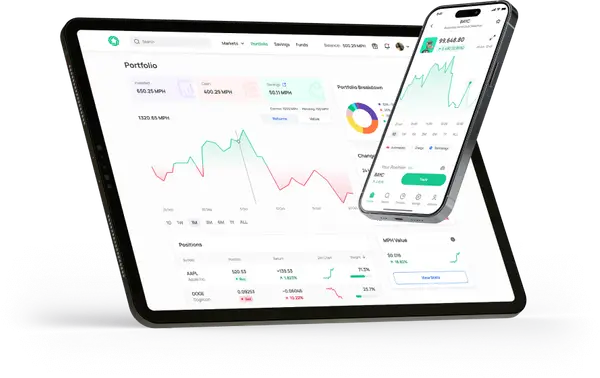
Earnings Reports

One of our personal favourite things that influence volatility is earnings. When earnings get published, it can literally decide the faith of the company going forward. Think of the trading floor going nuts after earning reports get released, similar to the headline above. In fact, people have already made big money on correctly predicting a company's upcoming earnings. In fact, there was a crazy story once where fraudsters got their hands on the reports prematurely and knew where the stock would go before the market opened. These fraudsters made millions in the process but obviously got caught at some point. As we do not want you to engage in illicit activities, we will show you how earning reports add to the volatility of a stock.
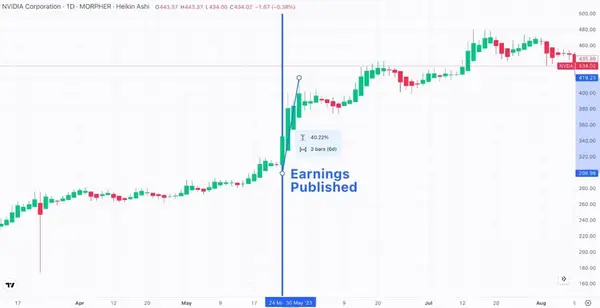
In this case, we are actually examining the NVIDIA stock that was mentioned in the news. As you can see from the chart above, the earnings were published on May 24, 2023. The earnings were highly positive, and NVIDIA crushed the expectations of analysts. So, the stock surged at the opening. Within a few days, the stock price increased from around 299 to 419, a whopping 40%. Now, that is some volatility you should not miss out on.
A case like this shows that earning reports can add a lot of fuel to the volatility of a stock, and if anticipated correctly, you can make use of that, as seen in the NVIDIA case. In fact, stock market volatility peaks in the first hours of trading, which is perhaps also related to earnings.
From the chart above, it's evident that the earnings were released on May 24, 2023, leading to a significant surge in trading volume and stock price movement. In just a few days, the stock's price jumped from roughly 299 to 419, an impressive 40% increase. This underscores the point that earnings reports can greatly influence a stock's volatility. And if one can correctly anticipate this volatility, there are gains to be made. Notably, stock market volatility tends to peak during the initial hours of trading, which might also be influenced by earnings reports.
Economic Indicators
Economic Indicators are another factor that can influence whether stocks are volatile or not. In fact, some economic indicators can set the mood for a whole sector or economy. Probably, the most important indicator is the interest rate of the Federal Reserve. As of lately, from March 2022 to July 2023, the funds rate increased by 500bps in only 16 months.

Now, Goldman Sachs actually found that hedge funds tend to perform much better in periods of high volatility, high inflation and high-interest rates.
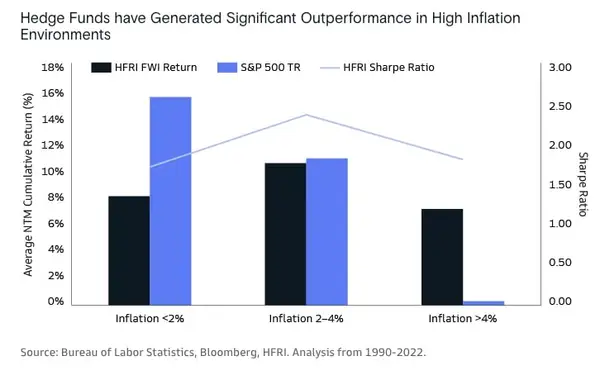
Okay, but what can individual investors like you learn from that? The main point here is that when interest rates are 0, inflation is around the target rate of 2%, and we generally have a low volatility environment, it is better to follow the herd and ride the wave. However, once we shift away from these favourable environments, we need to change the strategy. In times of high volatility, it might be better for individual stock picking, and more opportunities might arise to find undervalued or overvalued assets. So here are some strategies to consider:
Play it Both Ways: Hedge funds often go both long and short. You can consider a similar strategy. For example, go long on sectors that traditionally benefit from inflation, like energy, while going short on sectors that struggle, like consumer discretionary.
Utilize Options: Think about buying put options to shield your investments. It's akin to having an insurance policy for your stocks. You fork out a little upfront, but if the stock nosedives, you have the safety net to sell at a fixed, higher price.
Cash Reserves: It's wise to hold onto some cash or its equivalents in your portfolio. This way, when a golden opportunity presents itself, you've got the funds ready to jump in.
Rapid shifts in the economic scene can feel daunting. But they also pave the way for proactive moves, letting us potentially tap into the volatility. All we've got to do is strategize wisely.
If you’re interested in short selling, try Morpher. Our platform makes it extremely easy to short any asset, does not require any margin accounts or keeping up a maintenance margin, and even has negative balance protection.
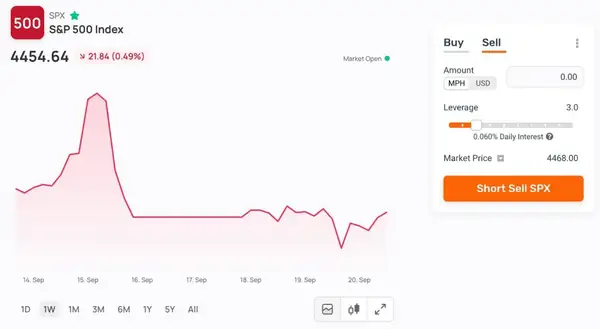
Want to follow in the footsteps of renowned investor Michael Burry, who recently went big by shorting the S&P500 with $1.6 billion? On Morpher, it's straightforward. Simply hit the “Sell” button. Plus, you can ramp up your game with up to 10x leverage. It's that easy.
Rumours and Speculation
Finally, rumours and market speculation. Only in recent years have we seen great examples of that, the most notable being the GameStop (GME) rally. In fact, the effects go beyond just GameStop. Traders also tried similar strategies in companies such as AMC, Blackberry, and Bed Bath & Beyond.

However, let us focus on the GameStop chart above and recap the legendary GameStop saga with these god candles going from $10 to $120 in a couple of days. The GameStop phenomenon offers a textbook case of how rumours and speculation can fuel stock market volatility. At the heart of it was a struggling company with dwindling revenues, heavily shorted by hedge funds.
However, Reddit traders, led by someone known as “Roaring Kitty,” orchestrated a counter-movement to trigger a “short squeeze,” forcing hedge funds to buy back shares at skyrocketing prices. The scheme went viral, attracting a surge of retail investors inflamed by FOMO (Fear of Missing Out), and pushing GameStop to become the most exchanged equity in the world for a time. This high-stakes game blurred traditional market dynamics, proving that in an age of commission-free trades and widespread online discussion, speculation and rumours can significantly amp up market volatility, creating both ups and downs for different market participants.
Most Volatile Stocks to Watch
In this part, we will show you our list of most volatile stocks to watch. If you want to compile your up-to-date list, you can do so with Yahoo’s Stock Screener App. Here are our filters.
- Region: United States
- Market Cap: Large Cap & Mega Cap
Our rationale behind picking only volatile large-cap and mega-cap stocks is that they combine elements of both worlds: the stability and resources of a large company with the price fluctuations that offer trading opportunities. For example, Tesla (TSLA) is a large-cap stock with high volatility, primarily due to its disruptive technology, regulatory news, and market sentiment driven by its high-profile CEO, Elon Musk. Such stocks may offer the prospect of significant short-term gains without the extreme risk associated with smaller, less stable companies.
- Beta (5Y Monthly): > bigger than 2.0
You might wonder what the “Beta” criterion is. We use it to assess the volatility of a stock; it is our primary filter. It measures a stock's volatility compared to the broader market over a 5-year period, with the data updated monthly. Essentially, it tells you how much the stock tends to move compared to a benchmark index, in this case, the S&P 500. So, a metric greater than >2.0 means we are tracking highly volatile stocks that can move dramatically more than the overall market. A beta of >2.0 indicates that the stock is expected to be at least twice as volatile as the market.

This criteria gave us a list of 32 results.
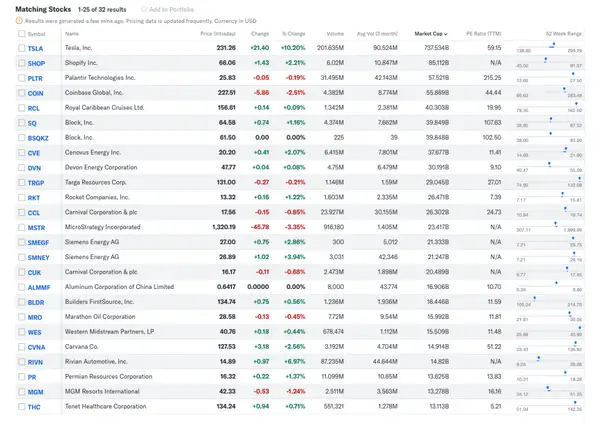
This criterion gave us a list of results.
1. Tesla, Inc. (TSLA)
- Price (Intraday): $231.26
- 52-Week Range: $138.80 – $299.29
- P/E Ratio (TTM): 59.15
- Market Cap: $737.534B
- Average Volume (3 months): 90.524M
Tesla remains a highly volatile stock due to its innovative technology, regulatory news, and market sentiment driven by its CEO, Elon Musk. The wide price range and high trading volume reflect its significant price fluctuations.
2. Shopify Inc. (SHOP)
- Price (Intraday): $66.06
- 52-Week Range: $45.50 – $91.57
- Market Cap: $85.112B
- Average Volume (3 months): 10.847M
Shopify’s volatility stems from its transformation in the e-commerce space and fluctuations in market sentiment post-pandemic. Its price movements are also influenced by the broader technology sector trends.
3. Palantir Technologies Inc. (PLTR)
- Price (Intraday): $25.83
- 52-Week Range: $13.68 – $27.50
- P/E Ratio (TTM): 215.25
- Market Cap: $57.521B
- Average Volume (3 months): 42.143M
Palantir’s stock is influenced by speculative trading, a lack of clear earnings-based valuation, recent AI hype, and securing multiple government contracts.
4. Coinbase Global Inc. (COIN)
- Price (Intraday): $227.51
- 52-Week Range: $69.63 – $283.48
- P/E Ratio (TTM): 44.44
- Market Cap: $55.869B
- Average Volume (3 months): 8.774M
Coinbase is another stock with high volatility due to its ties to the cryptocurrency market, which is known for its rapid price changes. The volatility of cryptocurrencies directly impacts Coinbase’s stock price.
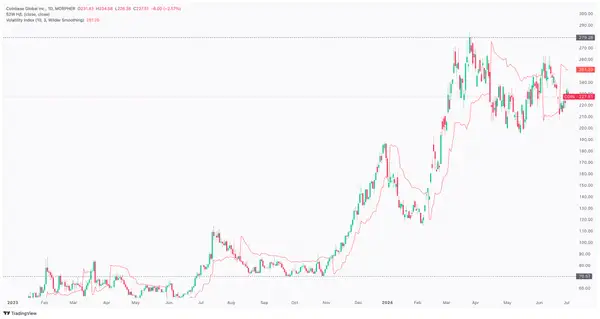
5. Royal Caribbean Cruises Ltd. (RCL)
- Price (Intraday): $156.61
- 52-Week Range: $78.35 – $162.50
- P/E Ratio (TTM): 19.95
- Market Cap: $40.303B
- Average Volume (3 months): 2.381M
The volatility in Royal Caribbean Cruises' stock is influenced by the travel industry's uncertainties and market sentiment related to travel restrictions and recovery.
6. Block Inc. (SQ)
- Price (Intraday): $64.58
- 52-Week Range: $38.85 – $87.52
- P/E Ratio (TTM): 107.63
- Market Cap: $39.849B
- Average Volume (3 months): 7.662M
Block’s volatility is tied to the evolving landscape of cryptocurrency markets, as the company has significant exposure to Bitcoin. Additionally, controversies surrounding its Cash App business have led to investor skepticism and significant price swings.
7. Carnival Corporation & plc (CCL)
- Price (Intraday): $17.56
- 52-Week Range: $10.84 – $19.74
- P/E Ratio (TTM): 24.73
- Market Cap: $26.302B
- Average Volume (3 months): 30.155M
Carnival Corporation’s stock is highly volatile due to the ongoing uncertainties in the travel sector, particularly related to pandemic recovery and travel demand fluctuations.
8. MicroStrategy Incorporated (MSTR)
- Price (Intraday): $1,320.19
- 52-Week Range: $307.11 – $1,999.99
- Market Cap: $23.417B
- Average Volume (3 months): 1.405M
MicroStrategy’s volatility is largely driven by its substantial holdings in Bitcoin and the associated fluctuations in cryptocurrency markets.

9. Rivian Automotive, Inc. (RIVN)
- Price (Intraday): $14.89
- 52-Week Range: $8.26 – $28.06
- Market Cap: $14.828B
- Average Volume (3 months): 44.644M
Rivian’s volatility is influenced by its position in the highly competitive electric vehicle market and production challenges.
Meme Stocks to Watch
Meme stocks are back again! Investors saw a highly volatile meme stocks market this year. Here are the top 3 most popular and volatile meme stocks:
- GameStop (GME)
GameStop became the poster child for meme stocks largely because of its significant short interest and the retail investor sentiment to wage a “short squeeze” against institutional investors. Its volatility is heavily driven by social media hype, particularly from Reddit's WallStreetBets forum, and the desire among small investors to challenge Wall Street norms. - AMC Entertainment (AMC)
Similar to GameStop, AMC was chosen by retail investors for its high short interest and perceived undervaluation. The stock became a symbol for the plight of businesses heavily impacted by the COVID-19 pandemic, and retail investors aimed to both make a profit and “save” a well-liked business. This social media-driven movement causes extreme volatility. - Bed Bath & Beyond (BBBY)
Chosen for its high short interest and reputation as an outdated brick-and-mortar store, Bed Bath & Beyond became a target for retail investors looking to exploit Wall Street's bearish outlook on the company. Its volatility is fueled by the tug-of-war between institutional short sellers and retail investors who congregate in online forums.
Trading mid-cap meme stocks could offer even greater induced volatility and therefore potential for higher returns because they are generally less liquid and more susceptible to market sentiment than large-cap stocks. However, you should always be very careful trading these companies. The lower market capitalization means that relatively smaller amounts of buying or selling activity can result in larger price swings, making them prime targets for the kind of social media-driven trading that characterizes meme stocks.
Are Volatile Stocks Good or Bad for Investing?
Whether volatile stocks are good or bad for investing largely depends on individual factors such as investment goals, risk tolerance, and time horizon. As Sebastian Lyon, founder and CIO at Troy Asset Management, points out, the concentration of market performance in “a handful of stocks” can signal a bear market's unfinished business, thus warning against investment in volatile stocks. This sentiment might resonate more with long-term investors or those with low-risk tolerance.
On the other hand, Nick Train of Lindsell Train argues that the “exceptional growth and profitability” in volatile tech stocks can offer fruitful returns, which may be more appealing to investors who are risk-tolerant and seek short-term gains.
Andrew Slimmon from Morgan Stanley Asset Management presents historical data indicating that “weak breadth itself isn't a precursor of market weakness,” suggesting that the market is often up the subsequent year following megacap leadership. So, for those with a longer time horizon, volatility might not be a decisive factor. This article puts forward a nice strategy to follow:
“Our preferred approach to short-term price volatility is to accept that we cannot predict market cycles, and instead focus on stocks with the biggest long-term upside.”
Or, as Charlie Munger notes, focusing on stocks with long-term upside can be more beneficial than trying to predict market cycles. Therefore, whether volatile stocks are good or bad for your portfolio hinges on your personal investment strategy and how comfortable you are with the level of risk involved.
Tips for Trading Volatile Stocks
Risk Management
One of the essential aspects of trading volatile stocks is effective risk management. Use tools like stop-loss orders to minimize losses and determine your position size based on risk tolerance. We want to stress that you must at all times approach investing and trading with a disciplined approach. You need to have a solid knowledge base and understanding first, and then the power of critical evaluation to know when to act and when to sit back.
Emotional Discipline
In volatile markets, emotional discipline is crucial. As Benjamin Graham stated, success is not just about beating the market but about having a solid financial plan and emotional discipline. Keep your emotions in check and adhere to your trading strategy rather than getting swept away by market excitement. Failing to manage emotions can lead to poor decisions like clinging to losing stocks or prematurely selling winners, especially amidst trading volatile stocks.
Fundamental and Technical Analysis
Another tip for trading volatile stocks is using fundamental and technical analysis. We recommend using a mix of both, as it might increase your chances of spotting undervalued stocks and getting into the trade at the right time. It also helps you to make your own decisions and not rely on what others say or solely on market sentiment. Fundamental analysis is there to understand the company's intrinsic values and focus more on numbers from earnings reports. Technical analysis helps you to understand indicators according to price movements and shows you the best opportunities to move into and out of the market.
Remember, trading isn't about having a high IQ but about being disciplined and making informed decisions. It's okay to take risks, but they should be calculated and in line with your overall strategy.
Conclusion
We really hope you enjoyed this comprehensive article on volatility. Now, you can pick the most volatile stocks and understand how to game this volatility in your favour. We only have one thing to say: your trading strategy should align with your risk tolerance and financial goals. If you embrace greater volatility for higher returns, go for it. If you feel overwhelmed, perhaps start with a less volatile market like index investing. Also, if you do not know where to start, simply start with the list we provided. After all, practice is the path to mastery.
If you found this article valuable, you might also be interested in our trading platform, specifically designed for trading volatile stocks. You can get started in just two minutes, without KYC, but with features like up to 10x leverage and the ability to short any stock instantly.

Disclaimer: All investments involve risk, and the past performance of a security, industry, sector, market, financial product, trading strategy, or individual’s trading does not guarantee future results or returns. Investors are fully responsible for any investment decisions they make. Such decisions should be based solely on an evaluation of their financial circumstances, investment objectives, risk tolerance, and liquidity needs. This post does not constitute investment advice.

Painless trading for everyone
Hundreds of markets all in one place - Apple, Bitcoin, Gold, Watches, NFTs, Sneakers and so much more.

Painless trading for everyone
Hundreds of markets all in one place - Apple, Bitcoin, Gold, Watches, NFTs, Sneakers and so much more.



